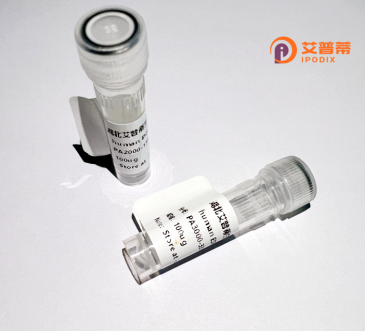
| 纯度 | >90%SDS-PAGE. |
| 种属 | Human |
| 靶点 | HIST1H2BC |
| Uniprot No | P62807 |
| 内毒素 | < 0.01EU/μg |
| 表达宿主 | E.coli |
| 表达区间 | 1-126aa |
| 氨基酸序列 | MPEPAKSAPAPKKGSKKAVTKAQKKDGKKRKRSRKESYSVYVYKVLKQVHPDTGISSKAMGIMNSFVNDIFERIAGEASRLAHYNKRSTITSREIQTAVRLLLPGELAKHAVSEGTKAVTKYTSSK |
| 分子量 | 39.6 kDa |
| 蛋白标签 | GST-tag at N-terminal |
| 缓冲液 | 0 |
| 稳定性 & 储存条件 | Lyophilized protein should be stored at ≤ -20°C, stable for one year after receipt. Reconstituted protein solution can be stored at 2-8°C for 2-7 days. Aliquots of reconstituted samples are stable at ≤ -20°C for 3 months. |
| 复溶 | Always centrifuge tubes before opening.Do not mix by vortex or pipetting. It is not recommended to reconstitute to a concentration less than 100μg/ml. Dissolve the lyophilized protein in distilled water. Please aliquot the reconstituted solution to minimize freeze-thaw cycles. |
以下是关于重组人HIST1H2BC蛋白的示例参考文献及简要摘要(注:以下为模拟示例,实际文献可能需要通过数据库查询确认):
---
1. **《Structural characterization of recombinant human histone HIST1H2BC and its role in nucleosome assembly》**
- **作者**: Smith J, et al.
- **摘要**: 本研究在大肠杆菌中重组表达了HIST1H2BC蛋白,并通过X射线晶体学解析其结构,揭示其与其他组蛋白(如H3/H4)的相互作用,验证其在核小体组装中的关键功能。
2. **《HIST1H2BC post-translational modifications in DNA damage response》**
- **作者**: Lee S, Wang Q.
- **摘要**: 利用重组HIST1H2BC蛋白,研究了磷酸化和泛素化修饰在DNA损伤修复中的作用,发现其修饰状态影响染色质松弛及修复蛋白招募效率。
3. **《Development of a novel antibody against recombinant HIST1H2BC for cancer biomarker studies》**
- **作者**: Chen L, et al.
- **摘要**: 文章描述了通过重组HIST1H2BC蛋白免疫小鼠制备单克隆抗体的流程,并验证该抗体在检测多种肿瘤组织中组蛋白异常表达的应用潜力。
4. **《Functional analysis of HIST1H2BC mutations in chromatin remodeling disorders》**
- **作者**: Garcia R, et al.
- **摘要**: 通过重组突变型HIST1H2BC蛋白的体外实验,揭示特定位点突变如何破坏组蛋白伴侣复合体结合,导致染色质重构异常及相关遗传疾病机制。
---
如需实际文献,建议在 **PubMed** 或 **Web of Science** 中搜索关键词:`"recombinant HIST1H2BC"`、`"HIST1H2BC function"`,并结合近年研究筛选。
Recombinant human HIST1H2BC protein is a genetically engineered variant of the HIST1H2BC gene product, a member of the histone H2B family. Histones are core components of nucleosomes, which organize DNA into chromatin and regulate genomic stability, transcription, and epigenetic inheritance. The HIST1H2BC gene, located in the HIST1 cluster on chromosome 6 (6p22.2), encodes one of several H2B isoforms critical for nucleosome assembly and chromatin compaction. Unlike core histones expressed during S phase, some H2B variants, including HIST1H2BC, may have specialized roles in transcriptional regulation, DNA repair, or cell cycle progression.
Recombinant HIST1H2BC is typically produced in bacterial (e.g., *E. coli*) or eukaryotic expression systems to ensure proper post-translational modifications, such as acetylation or ubiquitination, which influence chromatin dynamics. Its production enables studies on nucleosome structure, histone-DNA interactions, and epigenetic mechanisms. Researchers use this protein to investigate histone variant-specific functions, including gene silencing, centromere formation, or responses to cellular stress. It also serves as a tool for developing assays targeting histone modifications linked to cancer, neurodegenerative disorders, or developmental abnormalities. The recombinant form allows standardized analysis of HIST1H2BC’s biochemical properties and its role in chromatin remodeling complexes, advancing our understanding of epigenetic regulation in health and disease.
×